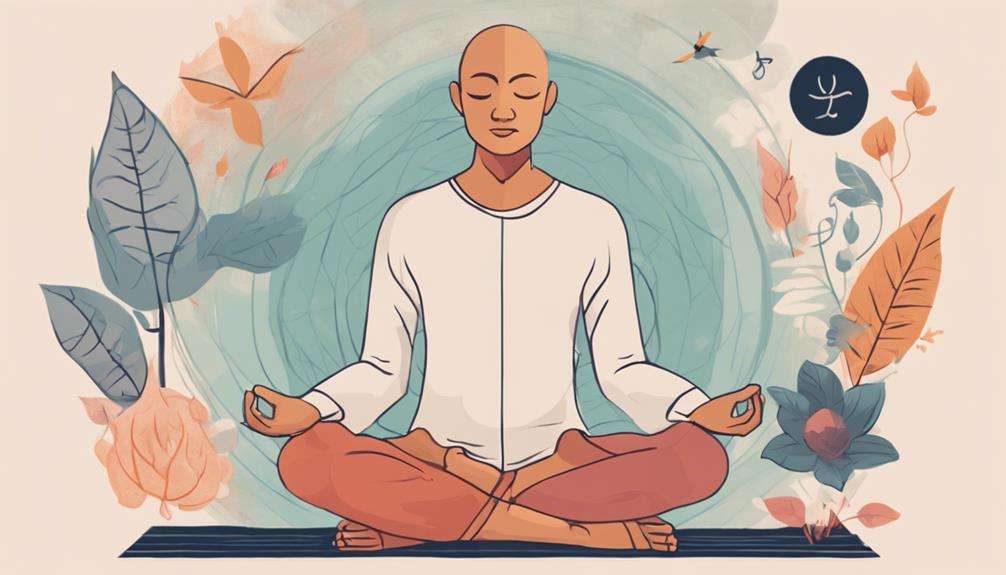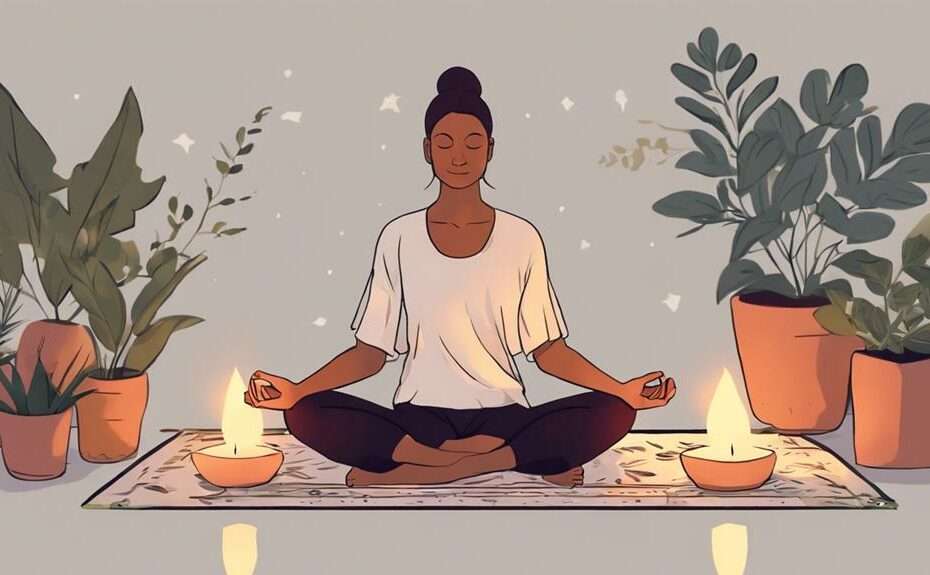Imagine your emotions as a vast ocean, sometimes calm and serene, other times turbulent and overwhelming. Through the ancient practices of yoga and meditation, you can learn to navigate these emotional waters with grace and resilience.
By embracing these techniques, you open the door to a journey of self-discovery and inner peace. Explore how these practices not only help in managing emotions but also lead to a profound transformation in your overall well-being.
Let's explore together how the path of emotional balance through yoga and meditation can enrich your life.
Key Takeaways
- Yoga and meditation reduce stress, promote emotional balance, and cultivate self-awareness.
- Mind-body connection regulates emotions and enhances emotional resilience.
- Techniques like pranayama and mindfulness meditation aid in emotional stability.
- Practicing yoga empowers emotional resilience and helps maintain balance in challenging situations.
Benefits of Yoga on Emotional Well-being
By reducing stress hormone levels and promoting emotional balance, yoga offers a powerful tool for enhancing your overall well-being. Through regular practice, you can cultivate a deeper sense of self-awareness, allowing you to better understand your emotions and how they manifest in your body and mind. The yoga postures and breathing techniques not only help in regulating your emotions but also contribute to increasing your emotional intelligence.
Moreover, the relaxation techniques incorporated in yoga practice can aid in calming the nervous system, reducing anxiety, and promoting a sense of inner peace. As you engage in these practices, you'll find yourself better equipped to navigate life's challenges with a greater sense of emotional stability and resilience. This emotional balance cultivated through yoga can have a profound impact on your overall quality of life, leading to improved sleep patterns and a more profound sense of emotional well-being. Embrace the power of yoga to nurture your emotional health and enhance your overall quality of life.
Importance of Meditation for Emotional Balance
Meditation plays a crucial role in fostering emotional balance by quieting the mind and establishing a deep mind-body connection.
By engaging in regular meditation practices, you can cultivate a sense of calmness and self-awareness that empowers you to manage negative emotions effectively.
This practice enhances your emotional resilience, allowing you to navigate challenging situations with grace and clarity.
Meditation for Calmness
To achieve emotional balance and cultivate a sense of calmness, incorporating meditation into your daily routine can be a transformative practice. Meditation for calmness is a powerful tool that helps reduce stress by lowering cortisol levels in your body, promoting a state of relaxation.
Through regular meditation practice, you can enhance your self-awareness and build emotional resilience, allowing you to better navigate life's challenges with a sense of inner peace. Mindful meditation not only calms the mind but also improves focus, clarity, and overall mental well-being.
Techniques like deep breathing and guided visualization are particularly effective in calming both your mind and body, helping you find a sense of tranquility amidst the chaos of daily life.
Mind-Body Connection
Enhancing your emotional balance through the practice of meditation involves fostering a deep connection between your mind and body, ultimately leading to a harmonious state of well-being. By focusing on the mind-body connection, meditation plays a crucial role in regulating emotions and promoting self-awareness.
Here are five ways meditation helps in achieving emotional balance:
- Calming the mind and reducing stress levels.
- Promoting self-awareness and inner peace.
- Regulating emotions in response to external stimuli.
- Managing anxiety disorders and depression.
- Strengthening the ability to recognize and manage negative emotional patterns.
Through regular meditation practice, you can cultivate a stronger mind-body connection, leading to improved emotional well-being and resilience.
Techniques for Emotional Stability Through Yoga

For cultivating emotional stability through yoga, incorporating specific breathing techniques and guided meditation practices can be transformative. By engaging in practices like Nadi Shodhana and Bhramari pranayama, you can restore emotional balance and clarity in your mind.
Deep belly breathing techniques are also beneficial, calming both body and mind, fostering emotional stability and mental clarity. Additionally, practices like Yoga Nidra, a form of guided meditation, aid in restoring emotional balance by promoting relaxation and reducing stress levels.
Mantras and meditation practices in yoga further contribute to emotional balance by enhancing self-awareness and inner peace. The holistic approach of yoga, which combines physical postures, breathing techniques, and meditation, is designed to enhance emotional stability, physical stamina, and mental clarity.
Embrace these techniques in your yoga practice to cultivate emotional stability and promote overall well-being.
Mindfulness Practices for Emotional Equilibrium
Cultivating emotional equilibrium through mindfulness practices involves focusing on the present moment without judgment, allowing you to observe your thoughts and emotions with clarity and awareness. Mindfulness is a powerful tool for achieving emotional balance and enhancing stress management. Here are five key aspects of mindfulness practices that can help you maintain emotional equilibrium:
- Present Moment Awareness: By staying present, you can prevent your mind from dwelling on past regrets or future worries, promoting emotional stability.
- Non-Judgmental Observation: Mindfulness encourages you to observe your thoughts and emotions without labeling them as good or bad, fostering a sense of acceptance and peace.
- Self-Awareness: Through mindfulness, you can develop a deeper understanding of your emotional triggers and patterns, empowering you to respond more skillfully to challenging situations.
- Emotional Regulation: Mindfulness equips you with the tools to regulate your emotions effectively, enabling you to navigate stressors with composure and resilience.
- Brain Rewiring: Regular mindfulness practice can rewire your brain, promoting emotional balance, well-being, and a more positive outlook on life.
Yoga Poses for Emotional Release

When you practice yoga, certain poses can help you find calmness and let go of pent-up emotions. These poses aim to release emotional tension, creating space for peace and balance within.
As you flow through these postures, allow yourself to connect with your emotions and let them go with each breath.
Poses for Calmness
To enhance emotional balance and promote calmness, incorporating specific yoga poses for emotional release can be incredibly beneficial. When practicing yoga for emotional well-being, consider including the following poses:
- Warrior 2 Pose: Find strength and stability, allowing yourself to let go of tension and invite peace into your mind.
- Half Pigeon Pose: Open up your hips, the 'junk drawer' of emotions, to release emotional trauma and find inner peace.
- Reclined Spinal Twist: Let go of anxiety and tension, cleansing both mind and body for a sense of calmness and clarity.
- Camel Pose: Activate your heart chakra, process heavy emotions, and release what no longer serves you.
- Humble Warrior Pose: Cultivate trust and surrender, fostering humility and balance in your emotional state.
Poses for Letting Go
Incorporate yoga poses specifically tailored for emotional release into your practice to cultivate a sense of liberation and inner peace. Poses like Half Pigeon and Camel help release emotional tension stored in the hips and heart, while Warrior 2 and Humble Warrior clear emotional cobwebs, fostering confidence and trust.
Reclined Spinal Twist aids in releasing mental and physical tension, promoting emotional cleansing. These poses offer a physical outlet for emotional release, assisting in processing heavy emotions. Practicing these poses mindfully can support emotional balance and inner peace through physical and mental alignment.
Embrace these poses as tools to let go of what no longer serves you, creating space for emotional healing and growth.
Meditation Methods for Inner Peace
For cultivating inner peace and emotional well-being, exploring various meditation methods such as mindfulness, loving-kindness, and body scan can be highly beneficial. Each technique offers a unique way to connect with your inner self and promote a sense of calmness.
Here are five meditation methods to help you find inner peace:
- Mindfulness Meditation: Focus on the present moment without judgment, allowing you to reduce stress and enhance emotional balance.
- Loving-Kindness Meditation: Cultivate compassion and empathy towards yourself and others, fostering emotional well-being and positivity.
- Body Scan Meditation: Systematically scan your body for tension, releasing it gradually to experience a deep sense of calm and relaxation.
- Mantra Meditation: Repeat a calming phrase or word to quiet the mind and center yourself in the present moment.
- Breath Awareness Meditation: Focus on your breath, observing its natural rhythm to anchor yourself in the present and promote inner peace.
These meditation practices can be incorporated into your daily routine to create a holistic approach towards achieving emotional balance and inner peace.
Yoga and Meditation Synergy for Emotions

Discover how the harmonious blend of yoga and meditation practices can profoundly impact your emotional well-being and inner balance. By combining these two powerful techniques, you can effectively manage your emotions, enhance self-awareness, and improve stress management.
Yoga postures, breathing exercises, and meditation all work together to calm the mind, reduce stress levels, and bring clarity to your thoughts and actions. This synergy helps regulate emotions, providing a stable foundation for your mental and emotional well-being.
Through the practice of yoga and meditation, you can cultivate a sense of inner peace and balance that extends into all aspects of your life. By incorporating these practices into your daily routine, you can experience a significant improvement in your ability to handle stress, manage your emotions, and achieve a greater sense of emotional stability.
Embrace the power of yoga and meditation to nurture your emotional balance and enhance your overall well-being.
Cultivating Emotional Resilience With Yoga
Engage in breathwork practices to cultivate emotional resilience, allowing you to navigate challenging situations with greater ease.
By incorporating mindfulness into your yoga routine, you can develop a heightened awareness of your emotions and thought patterns.
These techniques empower you to build a strong foundation of emotional stability and well-being.
Breathwork for Resilience
By incorporating breathwork techniques into your yoga practice, you can cultivate emotional resilience and inner calm, enhancing your overall well-being. As you engage in pranayama techniques, here are some ways breathwork fosters emotional resilience:
- Deep belly breathing soothes your nervous system, easing stress and anxiety.
- Alternate nostril breathing balances your energies, promoting emotional stability.
- Synchronized breathing with movement in yoga enhances your mental focus and clarity.
- Consistent breathwork practice reduces feelings of anxiousness and improves your mood.
- Research suggests that pranayama techniques can lower cortisol levels, helping you achieve a more balanced emotional state.
Embrace these techniques to strengthen your emotional resilience and find inner peace.
Mindfulness in Practice
Enhance your emotional resilience through mindfulness in yoga practice, fostering a deeper connection to your present moment experience.
Mindfulness in yoga allows for a heightened emotional awareness, enabling you to observe your feelings without judgment.
By incorporating mindfulness into your yoga and meditation routines, you can better regulate your emotions and decrease reactivity to stressors.
This practice cultivates self-compassion and acceptance, essential components for building emotional resilience in challenging circumstances.
Consistent mindfulness practice through yoga and meditation has the potential to rewire your brain, leading to improved emotional regulation and overall well-being.
Embrace the power of mindfulness to nurture your emotional balance and strengthen your ability to navigate life's ups and downs with grace.
Enhancing Emotional Intelligence Through Meditation

Through regular meditation practice, you can develop a deeper understanding of your emotions and enhance your ability to navigate them with greater awareness and compassion. Meditation plays a crucial role in enhancing emotional intelligence by increasing self-awareness and empathy. Here are five ways meditation can help boost your emotional intelligence:
- Improved Self-Awareness: Meditation allows you to observe your thoughts and emotions without judgment, leading to a better understanding of your inner world.
- Enhanced Empathy: By practicing meditation, you can cultivate compassion towards yourself and others, fostering stronger connections and empathy.
- Better Emotional Regulation: Regular meditation practice helps in managing and controlling your emotional responses, leading to a more balanced and composed demeanor.
- Increased Mindfulness: Through mindful meditation, you can develop a non-reactive attitude towards emotions, enabling you to respond thoughtfully rather than impulsively.
- Stress Reduction: Meditation aids in reducing emotional reactivity and stress levels, allowing you to approach challenging situations with a calmer mind.
Strategies for Emotional Harmony Through Practice
To cultivate emotional harmony through practice, consider incorporating yoga and meditation techniques that promote self-awareness and stress regulation. By engaging in practices that focus on calming the mind and body, you can effectively manage stress, improve emotional balance, and enhance overall well-being.
Techniques such as deep breathing exercises and mindfulness meditation can help you develop a greater sense of self-awareness, allowing you to recognize and regulate your emotional responses more effectively.
Regular practice of yoga poses like Half Pigeon, Camel, and Warrior 2 can aid in releasing emotional tension, promoting clarity of the mind, and fostering emotional resilience. These poses not only help to strengthen the body but also work to balance the mind and emotions.
Establishing a consistent routine of yoga and meditation can lead to better stress management, increased emotional stability, and a deeper sense of inner peace. By dedicating time to these practices, you empower yourself to navigate life's challenges with a sense of calm and emotional equilibrium.
Frequently Asked Questions
How Does Yoga Help With Emotional Regulation?
Yoga helps with emotional regulation by promoting breath awareness, enhancing mind-body connection, and providing stress relief. It guides you to be present, understand your emotions, and find calmness within yourself, fostering emotional stability.
What Is the Role of Yoga and Meditation in Coping With Emotions?
In coping with emotions, yoga and meditation play a vital role. Breathing techniques help manage stress, fostering a strong mind-body connection. By incorporating these practices, you can achieve emotional balance, enhancing overall well-being and inner peace.
Does Meditation Balance Emotions?
Meditation balances emotions by promoting mindfulness techniques, reducing stress, and enhancing emotional stability. It helps you cultivate inner peace and resilience. Consistent practice fosters self-awareness and emotional regulation, leading to improved well-being and mood.
What Are 5 Mental Emotional Benefits of Yoga?
Yoga enhances self-awareness, boosts mood, and improves resilience. It increases emotional balance, calms the mind, and strengthens the mind-body connection. Regular practice promotes relaxation, reducing stress effectively and enhancing overall mental well-being.
Conclusion
As you continue on your journey of yoga and meditation practice, remember that emotional balance is within your reach. Just like a tree swaying gracefully in the wind, you can navigate life's challenges with strength and flexibility.
By cultivating mindfulness and resilience, you can blossom into a more grounded and centered individual, capable of weathering any emotional storm that comes your way.
Keep practicing, keep growing, and keep shining your light brightly. You've got this.






